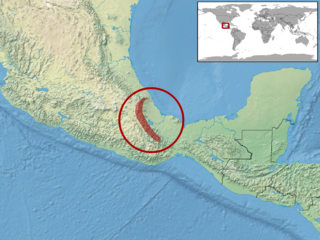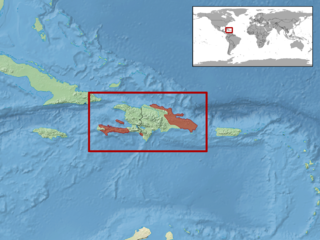
Diploglossus is a genus of New World diploglossid lizards, with 20 described species, commonly known as galliwasps.
Celestus fowleri, also known commonly as the bromeliad galliwasp and Fowler's galliwasp, is a species of lizard in the family Diploglossidae. The species is endemic to Jamaica.

Caribicus warreni, commonly known as the Haitian giant galliwasp or the Hispaniolan giant galliwasp, is a species of lizard in the family Diploglossidae. The species is endemic to the island of Hispaniola.

Diploglossidae is a family of anguimorph lizards native to the Americas, with most genera being endemic to Hispaniola. Most members of this family are known as galliwasps. They were formerly considered a subfamily of Anguidae, but genetic evidence has shown them to be less closely related to other members of Anguidae than Anniellidae is.

Panolopus marcanoi, commonly known as Marcano's galliwasp or Pico Duarte galliwasp, is a species of lizard in the family Diploglossidae. It is endemic to the Dominican Republic.
Wetmorena agasepsoides, the serpentine four-toed galliwasp, is an endangered species of lizard of the Diploglossidae family endemic to the Dominican Republic on the Caribbean island of Hispaniola.
Celestus barbouri, also known commonly as Barbour's galliwasp and the limestone forest galliwasp, is a species of lizard in the family Diploglossidae. The species is endemic to Jamaica.

Panolopus costatus, the Hispaniolan smooth galliwasp or common Hispaniolan galliwasp, is a species of lizard of the Diploglossidae family. It is endemic to the Caribbean island of Hispaniola.
Caribicus darlingtoni, also known commonly as Darlington's galliwasp and the Hispaniolan striped galliwasp, is a species of lizard in the family Diploglossidae endemic to the Dominican Republic on the Caribbean island of Hispaniola.

Siderolamprus enneagrammus, the Huaxteca lesser galliwasp, is a species of lizard of the Diploglossidae family. It is found in Mexico.
Wetmorena haetiana, the Hispaniolan earless galliwasp or earless galliwasp, is an endangered species of lizard of the Diploglossidae family endemic to the Caribbean island of Hispaniola.

Siderolamprus ingridae, Ingrid’s galliwasp, is a species of lizard of the Diploglossidae family. It is found in Mexico.
Siderolamprus legnotus, Campbell's galliwasp, is a species of lizard of the Diploglossidae family. It is found in Mexico.

Sauresia sepsoides, the Hispaniolan four-toed galliwasp or common four-toed galliwasp, is a species of lizard of the Diploglossidae family endemic to the Caribbean island of Hispaniola. It is the only member of the genus Sauresia.

Comptus stenurus, the Hispaniolan keeled galliwasp or Cope's galliwasp, is a species of lizard of the Diploglossidae family endemic to the Caribbean island of Hispaniola.
Siderolamprus atitlanensis, the Atitlán galliwasp, is a species of lizard of the Diploglossidae family. It is found in Mexico, Guatemala, and El Salvador.
Siderolamprus montanus, the mountain lesser galliwasp, is a species of lizard of the Diploglossidae family. It is found in Honduras.

Caribicus is a genus of diploglossid lizards endemic to the island of Hispaniola in the Caribbean, in both the Dominican Republic and Haiti.

Panolopus is a genus of diploglossid lizards endemic to the island of Hispaniola in the Caribbean, in both the Dominican Republic and Haiti.

Siderolamprus is a genus of lizard in the family Diploglossidae. They are found throughout much of Central America. They are considered the only members of the subfamily Siderolamprinae, although Diploglossus bilobatus is sometimes reclassified into the monotypic genus Mesoamericus and placed with them.









